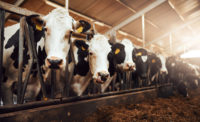Meat processors and food safety inspectors both want the same thing: safe food. However, the relationship between the two entities can be touch-and-go at times. At the best circumstances, state or local governments and small meat plants can work together to develop successful operations that produce quality meat items. At the other end of the scale, small plants can struggle to meet changing rules and regulations and even risk going out of business due to an inability to adapt or keep up with a mountain of documentation.
The American Association of Meat Processors has been making frequent trips to Washington D.C. to meet with Food Safety and Inspection Service (FSIS) leadership as well as key congressional representatives, on behalf of its member companies. That physical presence was one of the things lost to the COVID pandemic in 2020, but AAMP was not idle.
“Our work in Washington and the state capitols has been limited to phone calls, emails, and Zoom meetings during the last year, but we have seen results,” says Chris Young, AAMP Executive Director. “The pandemic and shutdown last year put a spotlight on the need for more capacity, and, in turn, more help for the small processor. This has brought a lot of attention and focus our way.”
The yeoman work done by the small and mid-sized meat processors to keep the supply chain moving when the large processing plants were idled from COVID outbreaks helped shine a light on the needs of small agriculture. Young says that AAMP has been a part of many discussions on state and national levels about the needs of the industry. As a result, more money has been made available at both levels so that small companies can improve and expand their operations.
“We have seen new legislation come forward that would be a great support to our members, and there is more on the way,” he adds. AAMP has given its support to H.R. 1258 and S.370, the “Strengthening Local Processing Act.” The Act provides small plants with the funds needed to grow and expand, and supports a scale-appropriate approach to small-scale slaughter and processing.
The Act does present good news for the small meat processing sector, but the industry does have issues to be wary of, too. Young notes that one rule change expected to be proposed this year involves the classification of naturally occurring nitrate, such as celery juice powder.
“Up until now, it has been considered a flavoring, but it will now become a source of nitrate. This means that a lot of products that have been labeled as ‘uncured’ or ‘no added nitrates’ will no longer be able to use that on the label,” he says.
Young adds that proposed changes to Appendix A and B, which have been discussed for several years, may be released this summer, though there is no timetable for the announcement. Those documents relate to Salmonella compliance guidelines for companies that produce RTE products and the stabilization of RTE and non-RTE products.
Some parts of the industry have unique challenges they must face. The country ham sector, for instance, uses new technology to mimic a time-tested dry-cured process. However, just because it’s called a ham doesn’t mean it’s processed the same way as other hams. That distinction can create hassles on occasion.
“The government likes to put everyone into a cubby hole that fits. If you’re making ham, all ham should fit in that cubby hole. This product is unique and doesn’t fit with 99% of all the ham in that category,” explains Sam Edwards III, president and owner of Edwards Virginia Smokehouse, located in Surry, Va.
Edwards Smokehouse is still recovering from a fire that destroyed its production facility in 2016, and its products – including country ham, sausage, bacon and more – are produced by co-packers. But the company is a long-time ham processor, and Edwards represents the third of four generations who have been active in the business. He says that some of the issues the company has experienced came from federal inspectors who knew about fresh poultry or beef plants but were not familiar with the rules and manufacturing processes that are unique to country hams.
“The antimicrobial benefits that you get from the dry-curing process puts it in a whole different category than a ham that’s pumped with water, which microbes actually love,” Edwards points out “We’re pulling water out of the meat along with adding salt, which is an antimicrobial. So we’re doing two things: We’re taking away moisture and we have an antimicrobial permeating the meat itself, which is our kill step.”
An ongoing source of frustration among domestic dry-cured meat companies is that the USDA allows imported products that are not held to the same regulatory levels as U.S. producers. Edwards notes that inspectors visit the plants overseas once in a while, but certainly not daily inspection that American processors get. Inspection of imported products can involve merely making sure that the products in the shipping container match what is written on the accompanying documentation.
“I’ve been to Europe to see what’s different about what they do. Some of the things I saw in those plants would never fly in a USDA plant, but they’re allowed to sell their product in this country,” Edwards says. “I’m not bashing what they do. I’m still satisfied that their products are safe. But some of the things we’re required to do goes above and beyond what are reasonable.” IP





Report Abusive Comment